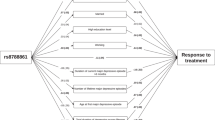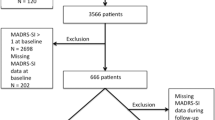Abstract
Hyperactivity of the hypothalamic–pituitary–adrenal (HPA) axis is among the most consistent neuroendocrine abnormalities in major depressive disorder (MDD). The peptide adrenocorticotropin hormone (ACTH) mediates HPA axis function during stress and is encoded by the proopiomelanocortin (POMC) gene polycistronically. After screening 39 POMC polymorphisms, we evaluated the association of polymorphisms with susceptibility to MDD in 145 MDD patients and 193 normal subjects; in patients, we also evaluated the response to treatment with antidepressants. Additionally, we investigated the role of gene–environment interaction between POMC haplotypes and stressful life events (SLE) in the treatment response. Although genotypes and haplotypes were not significantly associated with the risk of MDD, non-remitters were more likely to carry haplotype 1 (ht1) and to have no ht2 than were remitters (corrected P = 0.010–0.035). Although observations were limited in patients without SLE, a significant haplotype–SLE interaction was observed (P = 0.020). Additionally, at 1, 2, and 8 weeks of treatment, the 21-item Hamilton Depression Rating scores of MDD subjects with POMC ht2 were significantly (P = 0.003–0.044) lower than those of patients with ht1 in subjects those did not experience SLE. MDD subjects possessing POMC ht2 achieved remission significantly (P = 0.013; survival analysis) faster than patients with ht1. This study suggests that POMC haplotypes, via an interaction with SLE, are associated with antidepressant treatment outcomes in MDD patients. Regarding SLE, haplotypes of the POMC gene could be useful markers for predicting the response to antidepressant treatment in MDD patients.


Similar content being viewed by others
References
Aperia B, Bergman H, Engelbrektson K, Thoren M, Wetterberg L (1985) Effects of electroconvulsive therapy on neuropsychological function and circulating levels of ACTH, cortisol, prolactin, and TSH in patients with major depressive illness. Acta Psychiatr Scand 72:536–541
Beck AT, Ward CH, Mendelson M, Mock J, Erbaugh J (1961) An inventory for measuring depression. Arch Gen Psychiatry 4:561–571
Ben-Efraim YJ, Wasserman D, Wasserman J, Sokolowski M (2013) Family-based study of AVPR1B association and interaction with stressful life events on depression and anxiety in suicide attempts. Neuropsychopharmacol 38:1504–1511. doi:10.1038/npp.2013.49
Binder EB, Salyakina D, Lichtner P et al (2004) Polymorphisms in FKBP5 are associated with increased recurrence of depressive episodes and rapid response to antidepressant treatment. Nat Genet 36:1319–1325. doi:10.1038/ng1479
Binder EB, Owens MJ, Liu W et al (2010) Association of polymorphisms in genes regulating the corticotropin-releasing factor system with antidepressant treatment response. Arch Gen Psychiatry 67:369–379. doi:10.1001/archgenpsychiatry.2010.18
Chowdhury NI, Souza RP, Tiwari AK et al (2014) Investigation of melanocortin system gene variants in antipsychotic-induced weight gain. World J Biol Psychiatry 15:251–258. doi:10.3109/15622975.2013.858827
Cupic B, Stefulj J, Zapletal E, Matosic A, Bordukalo-Niksic T, Cicin-Sain L, Gabrilovac J (2013) Opioid system genes in alcoholism: a case-control study in Croatian population. Neuropeptides 47:315–319. doi:10.1016/j.npep.2013.08.002
de Keyzer Y, Lenne F, Auzan C et al (1996) The pituitary V3 vasopressin receptor and the corticotroph phenotype in ectopic ACTH syndrome. J Clin Invest 97:1311–1318. doi:10.1172/jci118547
De Kloet ER, Vreugdenhil E, Oitzl MS, Joels M (1998) Brain corticosteroid receptor balance in health and disease. Endocr Rev 19:269–301. doi:10.1210/edrv.19.3.0331
Dempster EL, Burcescu I, Wigg K et al (2007) Evidence of an association between the vasopressin V1b receptor gene (AVPR1B) and childhood-onset mood disorders. Arch Gen Psychiatry 64:1189–1195. doi:10.1001/archpsyc.64.10.1189
Doherty JL, Owen MJ (2014) Genomic insights into the overlap between psychiatric disorders: implications for research and clinical practice. Genome Med 6:29. doi:10.1186/gm546
Du H, Vimaleswaran KS, Angquist L et al (2011) Genetic polymorphisms in the hypothalamic pathway in relation to subsequent weight change—the DiOGenes study. PLoS One 6:e17436. doi:10.1371/journal.pone.0017436
Fang Z, Rajewsky N (2011) The impact of miRNA target sites in coding sequences and in 3′UTRs. PLoS One 6:e18067. doi:10.1371/journal.pone.0018067
Forman JJ, Coller HA (2010) The code within the code: microRNAs target coding regions. Cell cycle (Georgetown, Tex) 9:1533-1541
Fournier JC, DeRubeis RJ, Hollon SD, Dimidjian S, Amsterdam JD, Shelton RC, Fawcett J (2010) Antidepressant drug effects and depression severity: a patient-level meta-analysis. JAMA 303:47–53
Graff M, Ngwa JS, Workalemahu T et al (2013) Genome-wide analysis of BMI in adolescents and young adults reveals additional insight into the effects of genetic loci over the life course. Hum Mol Genet 22:3597–3607. doi:10.1093/hmg/ddt205
Grabe HJ, Schwahn C, Appel K et al (2010) Childhood maltreatment, the corticotropin-releasing hormone receptor gene and adult depression in the general population. Am J Med Genet B Neuropsychiatr Genet 153:1483–1493. doi:10.1002/ajmg.b.31131
Hamilton M (1960) A rating scale for depression. J Neurol Neurosurg Psychiat 23:56–62
Hayase T, Yamamoto Y, Yamamoto K (2002) Increased immunoreactivity of POMC-derived neuropeptides and immediate-early gene-derived proteins (c-Fos and Egr-1 proteins) as an early step of acute cocaine-induced stressor effects: comparison with the effects of immobilization stress. Nihon Arukoru Yakubutsu Igakkai Zasshi 37:586–596
Hedrick PW (1987) Gametic disequilibrium measures: proceed with caution. Genetics 117:331–341
Holsboer F (2000) The corticosteroid receptor hypothesis of depression. Neuropsychopharmacol 23:477–501. doi:10.1016/s0893-133x(00)00159-7
Holsboer F, Barden N (1996) Antidepressants and hypothalamic-pituitary-adrenocortical regulation. Endocr Rev 17:187–205. doi:10.1210/edrv-17-2-187
Ishitobi Y, Nakayama S, Yamaguchi K et al (2012) Association of CRHR1 and CRHR2 with major depressive disorder and panic disorder in a Japanese population. Am J Med Genet B Neuropsychiatr Genet 159b:429–436. doi:10.1002/ajmg.b.32046
Kendler KS, Kuhn JW, Vittum J, Prescott CA, Riley B (2005) The interaction of stressful life events and a serotonin transporter polymorphism in the prediction of episodes of major depression: a replication. Arch Gen Psychiatry 62:529–535. doi:10.1001/archpsyc.62.5.529
Kendler KS, Gatz M, Gardner CO, Pedersen NL (2006) A Swedish national twin study of lifetime major depression. Am J Psychiatry 163:109–114
Kessler RC, Berglund P, Demler O, Jin R, Koretz D, Merikangas KR et al (2003) The epidemiology of major depressive disorder: results from the National Comorbidity Survey Replication (NCS-R). JAMA 289:3095–3105
Khan A, Leventhal RM, Khan SR, Brown WA (2002) Severity of depression and response to antidepressants and placebo: an analysis of the Food and Drug Administration database. J Clin Psychopharmacol 22:40–45
Kirsch I, Deacon BJ, Huedo-Medina TB, Scoboria A, Moore TJ, Johnson BT (2008) Initial severity and antidepressant benefits: a meta-analysis of data submitted to the Food and Drug Administration. PLoS Med 5:e45
Kuehnen P, Mischke M, Wiegand S et al (2012) An Alu element-associated hypermethylation variant of the POMC gene is associated with childhood obesity. PLoS Genet 8:e1002543. doi:10.1371/journal.pgen.1002543
Lee H-Y, Kang R-H, Han S-W, Paik J-W, Chang HS, Jeong YJ, Lee M-S (2009) Association of glucocorticoid receptor polymorphisms with the susceptibility to major depressive disorder and treatment responses in Korean depressive patients. Acta Neuropsychiatrica 21:11–17
Liu Z, Zhu F, Wang G et al (2006) Association of corticotropin-releasing hormone receptor1 gene SNP and haplotype with major depression. Neurosci Lett 404:358–362. doi:10.1016/j.neulet.2006.06.016
Liu Z, Zhu F, Wang G et al (2007) Association study of corticotropin-releasing hormone receptor1 gene polymorphisms and antidepressant response in major depressive disorders. Neurosci Lett 414:155–158. doi:10.1016/j.neulet.2006.12.013
Meijer OC, de Kloet ER (1998) Corticosterone and serotonergic neurotransmission in the hippocampus: functional implications of central corticosteroid receptor diversity. Crit Rev Neurobiol 12:1–20
Mountjoy KG, Robbins LS, Mortrud MT, Cone RD (1992) The cloning of a family of genes that encode the melanocortin receptors. Science (New York, NY) 257:1248–1251
Nakanishi S, Inoue A, Kita T, Nakamura M, Chang AC, Cohen SN, Numa S (1979) Nucleotide sequence of cloned cDNA for bovine corticotropin-beta-lipotropin precursor. Nature 278:423–427
Papiol S, Arias B, Gasto C, Gutierrez B, Catalan R, Fananas L (2007) Genetic variability at HPA axis in major depression and clinical response to antidepressant treatment. J Affect Disord 104:83–90. doi:10.1016/j.jad.2007.02.017
Purcell S, Cherny SS, Sham PC (2003) Genetic power calculator: design of linkage and association genetic mapping studies of complex traits. Bioinformatics 19:149–150
Schule C (2007) Neuroendocrinological mechanisms of actions of antidepressant drugs. J Neuroendocrinol 19:213–226. doi:10.1111/j.1365-2826.2006.01516.x
Shadrina M, Nikopensius T, Slominsky P et al (2006) Association study of sporadic Parkinson’s disease genetic risk factors in patients from Russia by APEX technology. Neurosci Lett 405:212–216. doi:10.1016/j.neulet.2006.06.066
Stephens M, Smith NJ, Donnelly P (2001) A new statistical method for haplotype reconstruction from population data. Am J Hum Genet 68:978–989. doi:10.1086/319501 S0002-9297(07)61424-4 (pii)
Suzuki M, Egashira N, Kajiya H et al (2008) ACTH and alpha-subunit are co-expressed in rare human pituitary corticotroph cell adenomas proposed to originate from ACTH-committed early pituitary progenitor cells. Endocr Pathol 19:17–26. doi:10.1007/s12022-008-9014-6
Takahashi A, Mizusawa K (2013) Posttranslational modifications of proopiomelanocortin in vertebrates and their biological significance. Front Endocrinol (Lausanne) 4:143. doi:10.3389/fendo.2013.00143
Ternouth A, Brandys MK, van der Schouw YT, Hendriks J, Jansson JO, Collier D, Adan RA (2011) Association study of POMC variants with body composition measures and nutrient choice. Eur J Pharmacol 660:220–225. doi:10.1016/j.ejphar.2010.10.112
van West D, Del-Favero J, Aulchenko Y et al (2004) A major SNP haplotype of the arginine vasopressin 1B receptor protects against recurrent major depression. Mol Psychiatry 9:287–292. doi:10.1038/sj.mp.4001420
Wang F, Gelernter J, Kranzler HR, Zhang H (2012) Identification of POMC exonic variants associated with substance dependence and body mass index. PLoS One 7:e45300. doi:10.1371/journal.pone.0045300
Wasserman D, Sokolowski M, Rozanov V, Wasserman J (2008) The CRHR1 gene: a marker for suicidality in depressed males exposed to low stress. Genes Brain Behav 7:14–19. doi:10.1111/j.1601-183X.2007.00310.x
Wolkowitz OM, Reus VI, Manfredi F, Ingbar J, Brizendine L, Weingartner H (1993) Ketoconazole administration in hypercortisolemic depression. Am J Psychiatry 150:810–812
Wong ML, Kling MA, Munson PJ et al (2000) Pronounced and sustained central hypernoradrenergic function in major depression with melancholic features: relation to hypercortisolism and corticotropin-releasing hormone. Proc Nat Acad Sci USA 97:325–330
Xiao Z, Liu W, Gao K et al (2011) Interaction between CRHR1 and BDNF genes increases the risk of recurrent major depressive disorder in Chinese population. PLoS One 6:e28733. doi:10.1371/journal.pone.0028733
Zhang H, Kranzler HR, Weiss RD et al (2009) Pro-opiomelanocortin gene variation related to alcohol or drug dependence: evidence and replications across family- and population-based studies. Biol Psychiatry 66:128–136. doi:10.1016/j.biopsych.2008.12.021
Zobel A, Schuhmacher A, Jessen F et al (2010) DNA sequence variants of the FKBP5 gene are associated with unipolar depression. Int J Neuropsychopharmacol 13:649–660. doi:10.1017/s1461145709991155
Acknowledgments
This study was supported by a Grant of the Korean Health Technology R&D Project, Ministry of Health & Welfare, Republic of Korea (Grant no. HI12C0003).
Author information
Authors and Affiliations
Corresponding author
Additional information
H. S. Chang and E. S. Won contributed equally to this work.
Electronic supplementary material
Below is the link to the electronic supplementary material.
702_2014_1333_MOESM2_ESM.pptx
Supplementary material 2 (PPTX 74 kb). Supplementary Figure S1. Kaplan–Meier survival analysis for the association of POMC haplotype 1 and haplotype 2 with the time of achieving remission after antidepressant treatment. P values were obtained using generalized Wilcoxson model
Rights and permissions
About this article
Cite this article
Chang, H.S., Won, E.S., Lee, HY. et al. The association of proopiomelanocortin polymorphisms with the risk of major depressive disorder and the response to antidepressants via interactions with stressful life events. J Neural Transm 122, 59–68 (2015). https://doi.org/10.1007/s00702-014-1333-9
Received:
Accepted:
Published:
Issue Date:
DOI: https://doi.org/10.1007/s00702-014-1333-9




